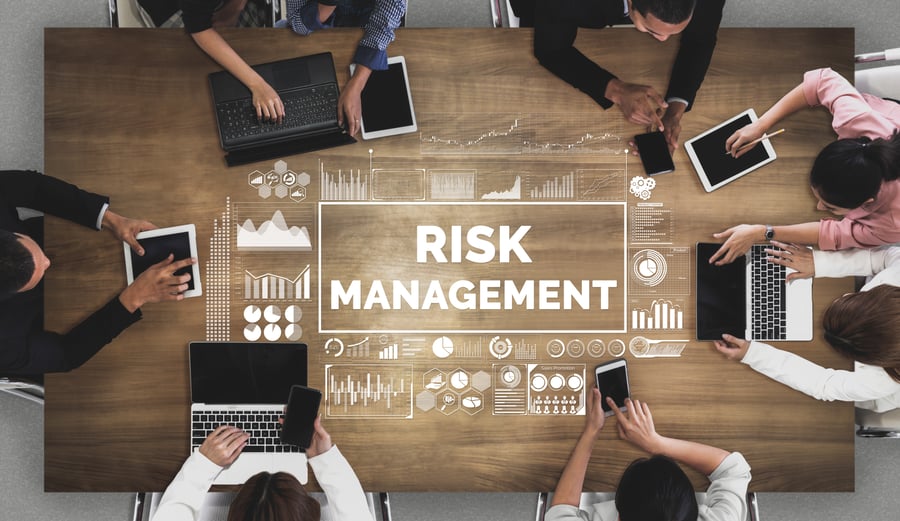With 22 years of experience at Creditsafe in the UK and USA, Michelle is a seasoned professional who thrives in our dynamic environment of evolving data, technology, and solutions. She particularly relishes the opportunity to work closely with customers, as evidenced by the numerous glowing references she has earned throughout her career.
By 2027, the AI market is expected to reach $407 billion.
Financial process automation
Whether you’re onboard the financial process automation train or not, the momentum isn’t going to slow down any time soon. And one industry that’s transforming rapidly is finance. Financial automation is changing processes, disrupting old beliefs and creating a new frontier for people working in the industry and the customers they serve.
Naturally, you might feel anxious about AI’s role in finance and how it impacts your job. But we’re here to tell you that it isn’t something to be pushed away or feared. Financial automation is game-changing. So, let’s explore 6 use cases so you can see for yourself.
Want to tap into the power of AI in your credit decisioning process?
Benefits of financial automation
1. Data management
Poor data quality and data management are major challenges for businesses. In our 'AI’s Role in Business Risk’ study, 27% of finance managers cited the need for strong data management and advanced analytics as their top concern for their business in 2023. Given how bad data costs organizations an average of $15 million a year, we aren’t surprised.
Lost revenue. Poor decision-making. Lack of insight into customer and supplier paying habits. The consequences of bad data can sink a business if left unchecked, which is why AI makes a massive difference.

In our recent ‘Financial Automation and AI: Mitigate Risk to Maximize Growth’ webinar, we talked to industry experts to hear their thoughts about data management. One of them was Nico McEwan, Business Development Manager at Quadient. He had this to say about AI’s role in financial data cleaning and forecasting.
“According to Resource Finance Pro, 41% of all accounting mistakes are because of manual processes. And 55% of leaders according to Blackline don't feel confident they identify financial errors before reporting the results. So, the first step to take is to have accurate data.
With financial automation, you have budgeting and forecasting tools. These can show you exactly what is going to be spent with your open purchase orders. It can automatically update the drawn amount as invoices come in. And then your remaining amount will automatically update too. So now you have that clear visibility for both the accounting team and the purchasing team to see what's happening with those purchase orders as the bills come in.
You also have easy search and report generation. So, the ability to search down by vendor date, period, whatever we need to, and then choose the columns we want. Maybe we’re interested in the descriptions of items. Or maybe we’re looking at the quantity that was received in relation to the quantity that was meant to be delivered.
Turning those insights into a report would typically be a manual process. It would take a lot of time. AI can help you do that with a few clicks. Now you have the kind of forecasting that CFOs love.”
Leighton Weston, Global Account Director at Creditsafe, weighed in too:
“A realistic time for company data to be cleansed is 24 hours. But it all depends on the size of your data and where you’re getting it from – is it coming from an ERP or a CRM system?
Bad data is the last thing you want. I dealt with a project where we found 4,000 customers that hadn’t matched up with outstanding balances that went beyond 90 days. So, what happened to all those customers? What happened to all the products that had been shipped? These are the kinds of questions that need to be asked and financial automation is a way to stop those problems from happening at the beginning.”
2. Risk assessment
Another common challenge we’ve seen is that finance doesn’t always understand the true ROI value of AI. Of the financial managers we surveyed in our ‘AI’s Role in Business Risk’ study, 63% said a lack of automation in financial processes creates little to no business risk. But there’s so much to be said about how AI can help with risk assessment.
Financing companies and banks can use machine learning algorithms to see whether a company is eligible for a loan or financing. Data like millions of dollars owed or high DBT scores of 15 and above will indicate how likely a business is to pay back a loan. And if these are high numbers, it’s a major red flag and will save your company a lot of stress further down the line.
We also want to point out the adaptation potential of machine learning. In a recent Netflix documentary called Unknown: Killer Robots, an experiment was run around a robotic dog. The creators, Improbable AI Lab, wanted to see how the robot dog would adapt to running on different surfaces made of various materials.
Over time, the dog got better at moving on surfaces that it originally fell over on because of machine learning. This was done through thousands of simulations being downloaded into the dog so it could adapt.
Put into a financial context, AI will get better at processing data and adapting based on different scenarios. It’ll learn to recognize the figures that mean an instant loan approval or red flags that require further investigation.

AI can also help lenders determine financial maturity and see how serious a business is about its own financial automation journey.
According to Sarah-Jayne Martin, Director of ICA Global AR Practice at Quadient, “Financial maturity is a scale of one through five of where you’re currently at in your automation process. Sometimes, there will be a certain level of maturity in one area and not a lot in another. We often run into clients that have all their customers receiving invoices via email. They’ve done a lot of steps but are still only accepting paper checks to an office location.
To assess where a company is on the financial maturity scale, you should cross-examine all your accounting processes. Be clear on what you plan to do, what you don’t plan to do and where you’re trying to get to.”
Nico McEwan, Business Development Manager at Quadient, added “When companies look at going digital, finance is usually left out. But it’s so important. I’ve heard financial teams say that paper is secure and that you can’t go wrong with it. But there’s a lot that can go wrong. You can lose documents. Data gets smudged, etc.
It’s definitely a time to go digital and update manual processes. Financial teams have noticed AI is helping invoices get paid faster and that it’s going to benefit them and vendors.”
When lenders see organizations with a high level of financial maturity, it indicates there are steps being taken to improve financial health. This could be a major deciding factor in whether a loan is granted or not.
3: Risk management
AI is an excellent risk mitigation tool, particularly when it comes to identifying new trends and protecting your supply chain. The health of your supply chain is directly related to the health of your business. Issues like product delays, unethical practices and labor shortages will have a knock-on effect that kills your bottom line and damages your reputation.
A shocking stat we found in our ‘Murky Waters of Overseas Manufacturing’ study is that 42% of brands would still work with a company even if they were involved in slave labor, corruption and bribery. There could be several reasons why this number is so high. Perhaps they have a lack of understanding of legal requirements. Or it could be that they simply value profit more than anything else – and aren’t as concerned about ethical sourcing. Whatever the reason, it’s not acceptable.
So, it’s vital that you have visibility into whether your suppliers have compliance violations for using child labor/foced labor, or if they have violated any sanctions. These markers will tell you how a customer or supplier is behaving and how they’ll impact the supply chain.
AI comes in handy in this situation. As Nico McEwan, Business Development Manager at Quadient, explains, “Supply chain risk management is a benefit people might not think of with financial automation. But these tools have to follow regulations and requirements and they do a lot of the work for you to make sure you and your team are up to par with industry standards.
You also need transparency with data. The technology can generate reports and spread it across more than just the core financial team. The department heads can also see what is being spent and what’s coming in.”

4: Credit decisions
Making credit decisions is standard business practice, but you shouldn’t sign a contract straight off the bat. You need to vet potential customers thoroughly. And nothing is ever straightforward. In fact, nearly half (46%) of finance managers said between 50-99% of their weekly credit decisions require in-depth analysis.
That’s not all. Our research found that for the majority (85%) of businesses, up to 10 people are involved in making credit decisions on new customers. Let’s put this into context with a real-life scenario. Imagine that an organization processes 500 credit applications a day and 5 people are involved in making those credit decisions. And the average annual salary for those 5 people $75,000. When you do the math, you’ll realize that you’re spending a lot of time and money on making credit decisions manually. And that time could be better spent on more strategic analysis of credit applications that aren’t so cut and dry.
That isn’t even considering all the errors that could happen from manual processing.
Missing and inaccurate data can lead to an unreliable analysis.
You could end up making assumptions about financial figures and not seeing the true risk a customer poses to your business.
You could be left with a high volume of redundant data that requires more time to update.
AI eliminates human error and automates repetitive manual tasks. It gathers, analyzes and reports on information that’s key to making credit decisions. This also means finance staff will be freed up to carry out more important tasks.

5. Fraud detection and prevention
AI-powered fraud management platforms help to protect against different scams, including identity theft, phishing attacks and payment fraud. A powerful example is Mastercard’s Decision Intelligence technology which traces fraudulent activities from different accounts and closes them down. The AI gathers data like account names, payee history and payment values and helps banks protect their customers in real time.
Here are more ways in which AI helps with fraud protection:
Purchase profiles: Machine learning algorithms gather large amounts of financial data to get a payment history of a customer. Over time, different categories are built up and a customer will be placed into a category to predict their future behavior.
Fraud scores: A transaction can be given a fraud score based on past data, such as legitimate purchases. Based on this score, a transaction can be approved or denied by a bank.
Ongoing fraud investigation: Thousands of transactions can be analyzed in real time and arranged in order of importance. In other words, suspicious purchases that need further investigation will be flagged as priorities.

6. Customer onboarding
This use case is an essential part of the customer experience and AI can help you improve it in several ways. The first is segmenting customers based on how likely they are to pay you. Working with a company that looks good on paper (i.e. a global brand with millions of customers), might seem great. But it doesn’t mean they’re going to pay on time. Looks can be deceiving.
The reality is that big companies tend to be the latest to pay, settling invoices 19 days past the payment terms date. Your business will be far more secure in the long term when you have customers that have gone through a rigorous onboarding process. This means blending AI into every step, from B2B credit checks and KYC/ID verification to AML screening and compliance checks.
Done traditionally, there would be multiple decision-makers involved. The process would be slow and frustrating for customers. With AI, you won’t be skimping on any of these crucial steps and it’ll be done in a fraction of the time. Weeks of reviewing, back-and-forth emailing and data gathering can be shaved down to minutes and seconds.
The same level of rigor applies to using AI for compliance checking. The technology will help you sift through various lists on a worldwide scale such as Counter Terrorism Sanctions, Cyber-Related Sanctions, Counter Narcotics Trafficking Sanctions and so much more.
Ways to streamline financial operations
Using Check & Decide can make your financial operations a lot smoother by automating credit and compliance checks, giving you instant and consistent decisions every time. This tool helps cut costs and errors, speeds up customer onboarding and sales, and ensures you always have up-to-date information from over 430 million companies. With easy-to-use templates and real-time data, you can quickly update policies and let authorized team members make accurate decisions. This means faster revenue, less friction between teams, and more efficient overall operations.

About the Author
Michelle Regan-Zamora